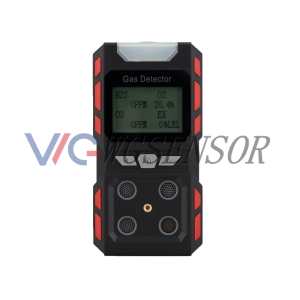Hydrogen sulfide (H2S) is a colorless, flammable, and highly toxic gas with a distinct odor reminiscent of rotten eggs. Despite its recognizable smell at low concentrations, prolonged exposure to even low levels of H2S can be hazardous to human health.
Health Hazards:
1. Toxicity: Inhalation of hydrogen sulfide can lead to various health issues, from eye irritation and respiratory problems to nausea, headache, and even unconsciousness. Exposure to higher concentrations can result in immediate loss of consciousness, respiratory failure, and death.
2. Environmental Impact: Beyond its human health risks, hydrogen sulfide poses threats to the environment. When released into the atmosphere or water bodies, it can harm aquatic life and disrupt ecosystems.
3. Corrosive Properties: Hydrogen sulfide is corrosive to metals, causing damage to equipment, infrastructure, and pipelines, leading to potentially dangerous situations and costly repairs.
Prevention using Gas Detectors:
Gas detectors are essential tools in mitigating the risks associated with hydrogen sulfide exposure. These detectors continuously monitor air quality, detecting and alarming in the presence of H2S, enabling timely action to prevent harm.
1. Types of Gas Detectors:
– Fixed Detectors: Installed in specific areas, these continuously monitor H2S levels and provide immediate alerts to prevent exposure.
– Portable Detectors: Ideal for mobile workers, these devices offer personal monitoring, alerting individuals if they enter areas with unsafe H2S levels.
2. Detection Strategies:
– Threshold Alarms: Gas detectors are set to trigger an alarm when H2S concentrations reach predetermined levels, allowing for swift evacuation or mitigation measures.
– Real-Time Monitoring: Some advanced detectors provide real-time data on H2S levels, enabling proactive measures and the identification of potential sources of leakage.
3. Safety Protocols:
– Training: Proper training in gas detection procedures and emergency responses is crucial for individuals working in environments prone to H2S exposure.
– Routine Maintenance: Regular calibration and maintenance of gas detectors ensure their accuracy and reliability in detecting hydrogen sulfide.
Conclusion:
Hydrogen sulfide presents significant health risks and environmental hazards. Utilizing gas detectors, both fixed and portable, is pivotal in preventing exposure and enabling quick responses to mitigate potential dangers. With proper training, maintenance, and adherence to safety protocols, the risks associated with H2S can be significantly reduced, ensuring a safer environment for all.
Remember, vigilance and preparedness are key to preventing the harmful effects of hydrogen sulfide exposure.


Please contact us for free quotation by form below. We promise the quickest response within 24 hours: